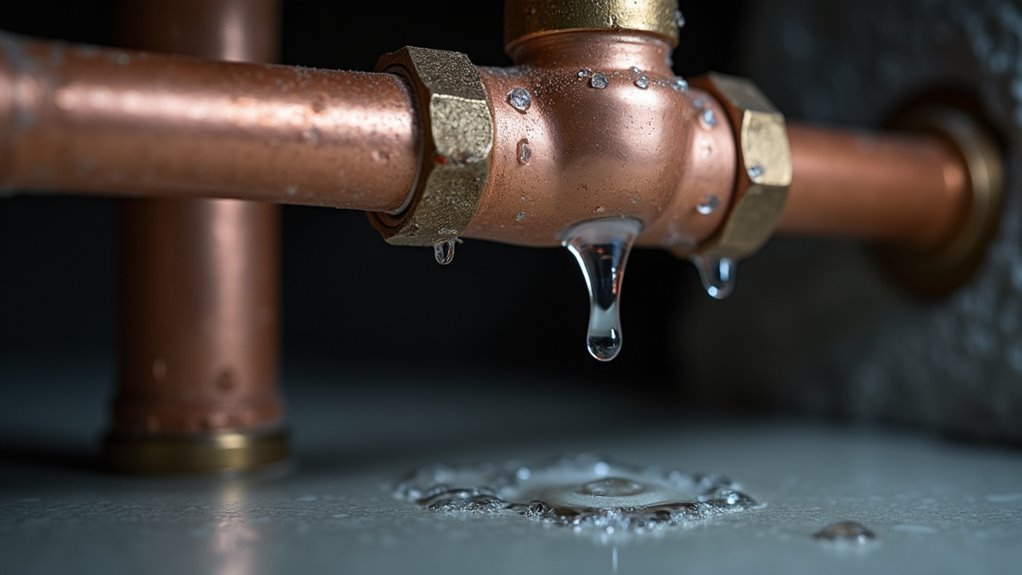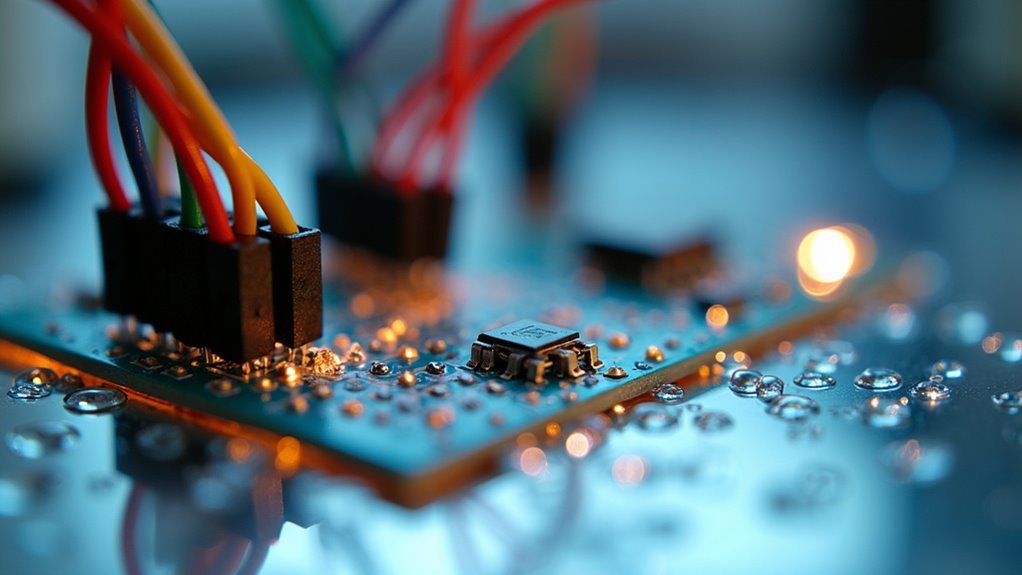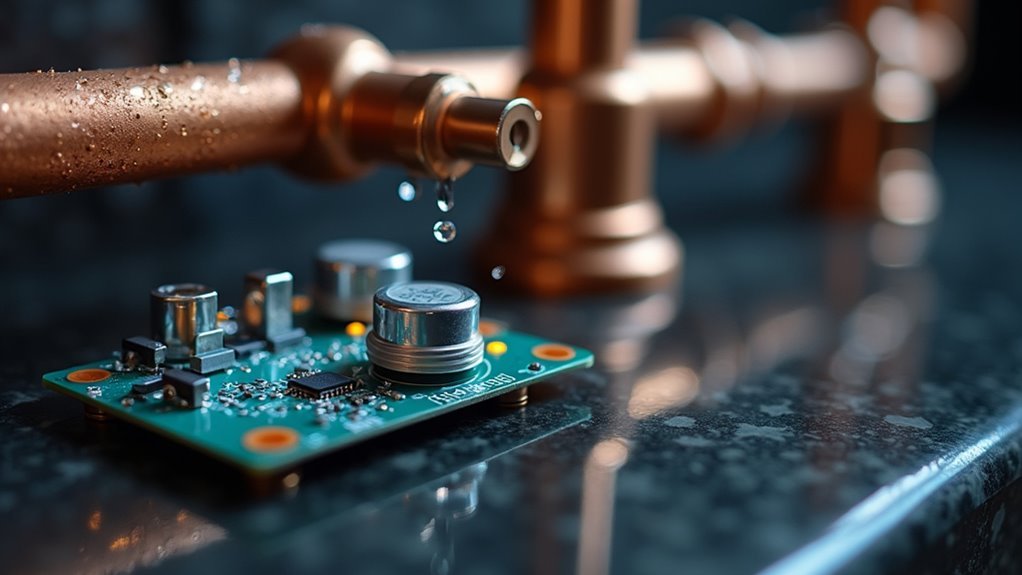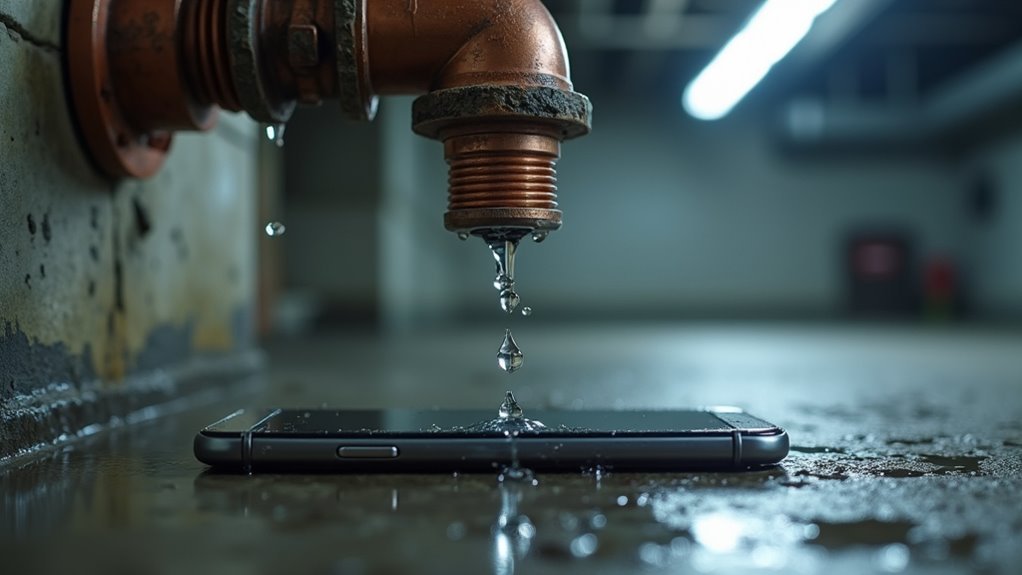You’ve probably noticed that commercial water leak detectors carry hefty price tags while offering limited customization for your specific home layout. Building your own system changes this equation entirely—you’ll cut costs by up to 80% while creating a detection network that actually fits your unique risk areas. The question isn’t whether you can afford to build one, but whether you can afford not to when water damage strikes unexpectedly.
Understanding the Basics of Water Leak Detection Technology

Water damage strikes when you least expect it, making early detection your first line of defense against costly repairs and property destruction.
Water leak detectors work by monitoring water flow or moisture levels through specialized sensors that identify problems before they escalate. These smart devices use various detection methods, including ultrasonic sensors that detect sound changes, moisture sensors that respond to water presence, and flow monitoring systems that track unusual water usage patterns.
Modern leak detection systems integrate seamlessly with home automation networks, sending real-time alerts directly to your smartphone when irregularities occur. Advanced models can automatically shut off your main water supply, preventing extensive damage while you’re away.
Understanding these fundamental technologies helps you choose the right components for building an effective, customized detection system.
Essential Components and Materials for DIY Water Leak Detectors
You’ll need to gather three categories of materials to build your water leak detector: core electronic components, the right sensors, and proper assembly tools.
Your component selection directly impacts both the detector’s reliability and your project’s total cost.
Let’s break down each category so you can make informed choices that match your budget and technical requirements.
Core Electronic Components
When building an effective water leak detector, you need several core electronic components that work together to monitor moisture levels and alert you to potential problems. Your water sensor serves as the foundation, detecting moisture through resistive or capacitive technology. A microcontroller like Arduino processes the sensor data and controls responses.
| Component | Type Options | Primary Function |
|---|---|---|
| Water Sensor | Resistive/Capacitive | Detects moisture presence |
| Microcontroller | Arduino/Raspberry Pi | Processes data and controls alerts |
| Power Supply | Battery/AC adapter | Provides system power |
| Alert System | Buzzer/LED/Speaker | Delivers immediate notifications |
For remote monitoring capabilities, you’ll want a Wi-Fi module such as ESP8266 for smartphone alerts. Don’t forget waterproof enclosures to protect your electronics from the very moisture they’re designed to detect.
Sensor Selection Guide
Choosing the right sensor determines your water leak detector’s effectiveness and reliability. When following any sensor selection guide, you’ll find that moisture sensors top the list for detecting humidity changes before minor issues become costly damage. These sensors provide early warning systems that can save you thousands in repairs.
Ultrasonic sensors offer another excellent option, using sound waves to identify water flow anomalies and deliver real-time alerts. For smart detection capabilities, you’ll want to integrate a microcontroller like Arduino or Raspberry Pi, enabling mobile app connectivity and remote notifications.
Remember that leak detectors come in various power configurations, so choose battery-operated or plug-in models based on your needs.
Always use waterproof enclosures to protect your investment from moisture damage.
Assembly Tools Required
Building a functional water leak detector requires specific components and tools that transform basic electronics into a reliable monitoring system.
You’ll need a microcontroller like Arduino or Raspberry Pi as your project’s brain, paired with water sensors that detect moisture presence. Essential assembly tools include a soldering iron for permanent connections, wire cutters for precise cable management, and a multimeter for troubleshooting electrical issues.
Your setup also requires jumper wires, a breadboard for prototyping, and alert components like buzzers or LEDs.
Consider adding a Wi-Fi module such as ESP8266 to enable smartphone notifications. Don’t forget your power supply to keep everything running.
Having these tools ready guarantees smooth assembly and helps you create a detector that’ll reliably protect your home from water damage.
Cost Comparison: DIY Vs Commercial Water Leak Detection Systems
When deciding between DIY and commercial water leak detection systems, you’ll need to weigh the initial investment costs against your budget and property needs.
Your long-term savings analysis should consider both the upfront expenses and potential costs from missed leaks or water damage over time.
You’ll also want to compare the feature value each option provides, as commercial systems often include advanced capabilities that DIY solutions can’t match.
Initial Investment Costs
Budget considerations play an essential role in deciding between DIY and commercial water leak detection systems.
When examining initial investment costs, you’ll find striking differences between approaches. Commercial systems typically cost $100 to $300, while DIY water leak detectors require just $20 to $50 in basic components like moisture sensors and microcontrollers.
This lower initial investment makes DIY particularly attractive for budget-conscious homeowners. You’ll also save on professional installation fees, which add another $100 to $200 to commercial systems.
While commercial options offer advanced features, DIY allows for customization based on your specific needs and financial constraints. Though DIY systems demand more setup time and maintenance effort, the significant upfront savings make them compelling for minimizing initial spending on leak detection.
Long-term Savings Analysis
Beyond the initial investment, long-term savings reveal where DIY water leak detectors truly shine in cost-effectiveness. Your homemade system can prevent catastrophic water damage averaging $12,514 in repair costs.
While you’ll spend under $50 on DIY solutions versus $300+ for commercial systems, the real value emerges over time.
Your leak detection system pays for itself through multiple avenues. First, you’ll catch leaks early, avoiding expensive structural repairs and mold remediation.
Second, you’ll reduce water waste—the EPA reports over 1 trillion gallons lost annually from household leaks. These hidden costs accumulate on your monthly bills.
Commercial systems offer advanced features at premium prices, but your DIY approach targets essential functionality.
You’re investing in protection that delivers measurable returns while maintaining complete control over your home’s monitoring capabilities.
Feature Value Comparison
Smart feature analysis reveals significant gaps between DIY and commercial water leak detectors that directly impact your investment’s value.
While DIY water leak detection systems cost under $50, they’ll miss critical capabilities like real-time notifications and automatic shut-off functions that commercial systems provide. You’re trading sophistication for savings, but this compromise affects leak prevention effectiveness.
Commercial systems justify their $100-$500 price tags with warranties, customer support, and reliable monitoring technology.
Your DIY detector might save money initially, but inadequate leak detection could expose you to thousands in cost of water damage.
Consider that professional detection services alone cost $200-$500 per inspection.
Commercial systems offer continuous monitoring that DIY solutions can’t match, making them more valuable for thorough property protection despite higher upfront costs.
Step-by-Step Guide to Building Your Own Water Leak Sensor
While commercial water leak detectors can cost hundreds of dollars, you can build an effective DIY version for under $20 using basic electronics components. Understanding how water leak detectors operate helps you create your own leak detection system effectively.
Start by connecting two conductive wires to an Arduino microcontroller – these wires complete a circuit when water’s present. Program the Arduino to trigger a buzzer or LED when detecting water contact. Add a power source like batteries for continuous monitoring.
For advanced functionality, incorporate a Wi-Fi module enabling smartphone alerts, mimicking commercial smart leak detectors. Place your sensor strategically near potential leak sources like water heaters or washing machines.
This DIY approach prevents costly repair costs while providing reliable water damage protection.
Programming and Calibrating Your Homemade Detection System

Once you’ve assembled your DIY water leak detector hardware, the real power comes from properly programming and calibrating the system for peak performance.
Start by programming your microcontrollers to process sensor readings with specific thresholds that determine when alerts trigger. You’ll need to adjust your moisture sensors’ sensitivity through careful calibrating to avoid false alarms while guaranteeing accurate water detection.
Proper threshold programming and sensor calibration are essential for preventing false alarms while ensuring reliable water leak detection.
Test your system in various environments to fine-tune threshold settings for different leak scenarios.
Configure your notification system to send SMS alerts or mobile app notifications when water’s detected. Regular software updates and sensor placement adjustments improve reliability.
This customization guarantees your homemade detector responds appropriately to actual leaks while minimizing unnecessary alerts, creating an effective water damage prevention system.
Strategic Placement Locations for Maximum Leak Detection Coverage
After programming your detector, you’ll need to strategically position sensors throughout your home to achieve extensive leak detection coverage.
Install your smart water leak detectors near high-risk areas like kitchens, bathrooms, and laundry rooms where plumbing fixtures are most vulnerable. Position sensors on your main water supply line to monitor your plumbing system’s primary source, enabling early leak detection before damage spreads.
Don’t overlook basements and crawl spaces—these areas harbor moisture infiltration and undetected leaks that cause mold growth.
For larger properties, strategic placement of multiple detectors guarantees thorough coverage and immediate alerts from various locations. You’ll minimize extensive damage from unnoticed leaks.
Consider professional assessment to optimize sensor positioning based on your home’s specific plumbing layout, maximizing your leak detection system’s effectiveness.
Integrating Your DIY Detector With Smart Home Networks

You’ll need to guarantee your DIY water leak detector supports common smart home protocols like Wi-Fi, Zigbee, or Z-Wave for seamless network integration.
Once you’ve confirmed compatibility, you can connect your detector to your home automation platform through a straightforward pairing process.
Setting up automated responses requires configuring triggers and actions within your smart home app to create customized leak detection routines.
Network Compatibility Requirements
While designing your DIY water leak detector, network compatibility stands as the foundation for seamless smart home integration.
You’ll need to verify your device operates on the 2.4 GHz frequency band, which most smart home devices use for ideal connectivity. Your detector must support standard communication protocols like MQTT or HTTP to enable effective automation and data exchange.
Consider your power requirements carefully, as some networks demand always-powered devices while others accommodate battery operation. This choice directly impacts your design decisions and long-term functionality.
Don’t forget to incorporate a mobile app or web interface for real-time alerts and monitoring capabilities.
This integration maximizes your detector’s effectiveness, allowing immediate response to potential leaks and thorough system management.
Automation Setup Process
Once your DIY water leak detector meets network compatibility requirements, the automation setup process begins with selecting your preferred smart home platform.
You’ll program your microcontrollers like Raspberry Pi or Arduino to communicate with your chosen network, enabling real-time leak detection and prevention alerts.
Configure your dedicated mobile app or web interface to receive instant notifications from your detector. This allows immediate monitoring and response from anywhere, greatly improving reaction times when leaks occur.
Most importantly, integrate a smart valve into your automation setup for automated water shut-off capabilities. When your detector identifies a leak, it’ll trigger the smart valve to stop water flow immediately, preventing extensive damage.
Remember to regularly update your microcontrollers’ firmware to maintain ideal security and system responsiveness.
Troubleshooting Common Issues With Homemade Water Sensors
Although building your own water leak detector can save money and provide customization options, several common issues may arise that require troubleshooting. Homemade water sensors often experience challenges that can compromise their effectiveness and reliability.
- False alarms from humidity – Environmental moisture can trigger unnecessary alerts, requiring sensor placement adjustments and sensitivity recalibration to distinguish between actual leaks and ambient conditions.
- Inconsistent sensitivity levels – DIY detectors may fail to detect leaks properly due to improper calibration, potentially allowing water damage to occur unnoticed.
- Wiring malfunctions – Loose connections or incorrect sensor placement can cause complete system failures, leaving your property unprotected.
- Power supply problems – Battery depletion or inadequate power sources can disable your sensors when you need them most.
Enhancing Your System With Advanced Alert Mechanisms
Five key upgrades can transform your basic homemade water leak detector into a sophisticated monitoring system that rivals commercial alternatives.
First, integrate mobile app connectivity for real-time notifications that’ll alert you instantly, regardless of your location.
Second, connect your system to smart home hubs, enabling alerts across multiple devices simultaneously.
Third, implement customizable alert settings that adjust notification types based on leak severity.
Fourth, incorporate ultrasonic technology to enhance detection accuracy and speed up response times.
Finally, add automated shut-off valves that’ll immediately stop water flow when your leak detection system triggers.
These advanced alert mechanisms work together to minimize water damage while maximizing your system’s effectiveness and reliability.
Testing and Validating Your DIY Water Leak Detector Performance
While building your DIY water leak detector represents a significant achievement, thorough testing determines whether your creation will actually protect your home when it matters most.
You’ll need to validate your detector’s performance through systematic evaluation before trusting it with real-world protection.
Start by conducting these essential tests:
- Simulate water exposure – Apply small amounts of water to various sensor locations and confirm accurate moisture detection with proper alerts.
- Measure response time – Validate that your detector triggers alarms within seconds of water contact for reliable performance.
- Compare against standards – Use a moisture meter to test your device against known wet and dry surfaces.
- Document results – Record any detection discrepancies or response delays to refine your system’s overall reliability.
Maintenance and Upgrading Your Homemade Detection Equipment
You’ve built and tested your water leak detector, but your work isn’t finished yet.
To keep your system running reliably, you’ll need to perform regular component inspections and implement system performance upgrades over time.
Let’s explore how to maintain your detector’s effectiveness and enhance its capabilities as technology advances.
Regular Component Inspection
Once you’ve built your water leak detector, maintaining its reliability requires consistent component inspection to catch potential issues before they compromise your system’s performance.
You’ll need to regularly inspect all critical parts to guarantee your homemade detector remains functional when you need it most.
Your inspection routine should focus on these essential elements:
- Sensors – Check moisture sensors for corrosion, damage, or buildup that could affect sensitivity
- Battery compartments – Look for corrosion, loose connections, or signs of battery leakage
- Wiring connections – Verify all connections remain secure and free from wear or damage
- Housing integrity – Examine the detector’s casing for cracks or water ingress that could cause malfunctions
This reliable maintenance approach prevents unexpected failures and keeps your detection system operating at peak performance.
System Performance Upgrades
After establishing a solid inspection routine, enhancing your water leak detector’s capabilities through strategic upgrades will greatly boost its detection accuracy and response effectiveness.
You’ll want to upgrade your sensors to more advanced capacitive or resistive moisture detection technology, which provides superior sensitivity compared to basic models.
Implementing a wireless notification system that sends real-time alerts to your smartphone guarantees you’re immediately informed of potential leaks, regardless of your location.
Don’t overlook the importance of using high-quality housing materials that resist degradation and prevent false alarms.
Finally, regularly review your calibration settings to maintain consistent performance as environmental conditions change, making sure your detector adapts and continues operating at peak efficiency.
Legal and Insurance Considerations for DIY Water Protection Systems
While DIY water leak detectors can save you money and provide customized protection, you’ll need to navigate several legal and insurance hurdles before installation.
First, check your local building codes to guarantee your DIY leak detection system meets required safety standards. Legal compliance isn’t optional—violations could create costly problems later.
- Contact your insurance company before starting your project to verify coverage requirements and potential premium discounts.
- Read your insurance policies carefully, as some explicitly require professionally installed systems for water damage claims.
- Document everything from design to installation and maintenance for future insurance claims.
- Keep detailed records of your DIY project to demonstrate proactive risk management to insurers.
Proper preparation protects both your property and your ability to file successful insurance claims.
Expanding Your System to Monitor Multiple Areas and Properties
As your DIY water leak detection system proves its worth in protecting your home, you’ll likely want to expand coverage beyond a single sensor. Installing leak sensors in high-risk zones like kitchens, bathrooms, and basements creates thorough monitoring that catches problems before they escalate.
Smart technology enables seamless integration across multiple properties, making this solution particularly valuable for property managers overseeing several locations. You’ll receive real-time alerts for each monitored area through a centralized app, allowing immediate response regardless of your location.
| Coverage Area | Risk Level | Recommended Sensors | Response Time |
|---|---|---|---|
| Bathroom | High | 2-3 sensors | < 5 minutes |
| Kitchen | High | 2 sensors | < 5 minutes |
| Basement | Critical | 3-4 sensors | < 3 minutes |
| Laundry Room | Medium | 1-2 sensors | < 10 minutes |
This expandable approach potentially saves thousands in repair costs while providing scalable protection.
Real-World Success Stories and Lessons Learned From DIY Projects
When Sarah Martinez detected water seeping into her basement at 2 AM through her $47 DIY leak detection system, she realized her weekend electronics project had just prevented what could’ve been thousands in flood damage.
Her story reflects countless DIY projects that’ve proven homemade sensors can match commercial performance while delivering substantial savings.
These success stories reveal valuable patterns:
- Cost-effectiveness: Most builders create functional systems under $50, compared to hundreds for commercial alternatives.
- Learning opportunities: You’ll gain electronics and programming skills through hands-on experience.
- Comparable accuracy: DIY systems achieve 95% leak detection rates, matching professional equipment.
- Smart integration: Smartphone notifications enable real-time alerts, ensuring you’re immediately aware of water damage risks.
Your DIY project could be the next success story preventing costly disasters.
Frequently Asked Questions
What Is the Purpose of a Water Leak Detection System?
A water leak detection system’s purpose is protecting you from costly damage by identifying leaks early. It prevents extensive repairs, inhibits mold growth, reduces water waste, and provides real-time alerts for immediate action.
What Is the Point of Leak Detectors?
You’ll prevent costly water damage averaging $12,514, stop mold growth that threatens health, reduce wasted water bills, receive instant mobile alerts, and boost your home’s resale value with proactive maintenance features.
What Is the Purpose of a Water Detector?
You’ll detect water leaks early to prevent costly damage to your home’s structure. Water detectors alert you immediately, helping you avoid expensive repairs and mold growth that’d compromise your family’s health.
Is a Water Leak Detector Worth It?
You’ll save an average of $12,514 in water damage repairs while preventing mold growth and health issues. Insurance discounts, increased home value, and water conservation make leak detectors a worthwhile investment.





Leave a Reply